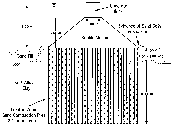4.6 Rubble Mound Breakwater in the Nishinomiya Area
4.6.1 Location and Treatment.
A rubble mound breakwater was located just offshore to the south of the filled area at the Nishinomiya side of the new Nishinomiya-Osaka bridge which suffered collapse of one span (see Section 3.4, Figure 3.60). A 2 to 3 m thick sand layer was placed over the soft alluvial clay, which had a thickness of 10 m at this location. Sand compaction piles were placed through both the sand and clay layers at 2.1 m on center. For offshore construction Fudo Construction Co., Ltd. used special equipment for installation of 2.0 m diameter sand compaction piles. The rubble mound embankment was placed directly on the treated ground, and the base of the embankment extended to the outer edge of the treated area. A rough approximation of the cross section of the breakwater and the treated ground, based on the information provided at the time of the reconnaissance, is shown in Figure 4.23.
 Figure 4.23: Inferred approximate cross section of the treated ground and rubble mound breakwater near Nishinomiya.
Figure 4.23: Inferred approximate cross section of the treated ground and rubble mound breakwater near Nishinomiya.
4.6.2 Performance
The breakwater settled from 1 to 2 m as a result of the earthquake. Divers reported evidence of sand boils at the toe of the rubble mound embankment. At the time of the reconnaissance, the failure mechanism had not yet been determined. Possibilities would appear to include (1) liquefaction of the sand adjacent to the treated zone with concurrent loss of lateral support, (2) liquefaction of the treated zone, (3) stability failure within the soft clay, and (4) combinations of all of these. Investigations of the observed behavior are continuing.
![]() Figure 4.23: Inferred approximate cross section of the treated ground and rubble mound breakwater near Nishinomiya.
Figure 4.23: Inferred approximate cross section of the treated ground and rubble mound breakwater near Nishinomiya.